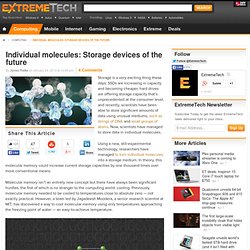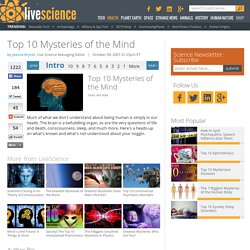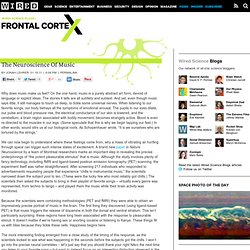

Molecules storage. Storage is a very exciting thing these days: SSDs are increasing in capacity and becoming cheaper, hard drives are offering storage capacity that’s unprecedented at the consumer level, and recently, scientists have been able to store significant amounts of data using unusual mediums, such as strings of DNA and small groups of atoms.

Now, scientists have managed to store data in individual molecules. Using a new, still-experimental technology, researchers have managed to turn individual molecules into a storage medium. In theory, this molecular memory could increase current storage capacities by one thousand times over more conventional means. Molecular memory isn’t an entirely new concept but there have always been significant hurdles, the first of which is no stranger to the computing world: cooling. The First Brain Transplant. Accelerating Future » Top 10 Transhumanist Technologies. Transhumanists advocate the improvement of human capacities through advanced technology. Not just technology as in gadgets you get from Best Buy, but technology in the grander sense of strategies for eliminating disease, providing cheap but high-quality products to the world’s poorest, improving quality of life and social interconnectedness, and so on. Inversion vieillissement. A technique to keep the tips of your chromosomes healthy could reverse tissue ageing.

The work, which was done in mice, is yet more evidence of a causal link between chromosome length and age-related disease. Telomeres, the caps of DNA which protect the ends of chromosomes, shorten every time cells divide. But cells stop dividing and die when telomeres drop below a certain length – a normal part of ageing. The enzyme telomerase slows this degradation by adding new DNA to the ends of telomeres. Mariela Jaskelioff and her colleagues at the Dana Farber Cancer Institute in Boston, Massachusetts, engineered mice with short telomeres and inactive telomerase to see what would happen when they turned the enzyme back on. Four weeks after the team switched on the enzyme, they found that tissue had regenerated in several organs, new brain cells were developing and the mice were living longer.
Journal reference: Nature, DOI: 10.1038/nature09603. Immortalité proche. Scientists’ depressing new discovery about the brain. This article originally appeared on Alternet.

Yale law school professor Dan Kahan’s new research paper is called “Motivated Numeracy and Enlightened Self-Government,” but for me a better title is the headline on science writer Chris Mooney’s piece about it in Grist: “Science Confirms: Politics Wrecks Your Ability to Do Math.” Top 10 Mysteries of the Mind. By Jeanna Bryner, Live Science Managing Editor | October 09, 2007 01:25pm ET Credit: NIH, NIDA Much of what we don't understand about being human is simply in our heads.

The brain is a befuddling organ, as are the very questions of life and death, consciousness, sleep, and much more. Le cerveau mystique. The Neuroscience Of Music - Wired Science. Why does music make us feel?

On the one hand, music is a purely abstract art form, devoid of language or explicit ideas. The stories it tells are all subtlety and subtext. And yet, even though music says little, it still manages to touch us deep, to tickle some universal nerves. When listening to our favorite songs, our body betrays all the symptoms of emotional arousal. 5 mind-bending facts about dreams. When your head hits the pillow, for many it's lights out for the conscious part of you.

But the cells firing in your brain are very much awake, sparking enough energy to produce the sometimes vivid and sometimes downright haunted dreams that take place during the rapid-eye-movement stage of your sleep. Human brain: fuse with computer chips biodigital brain. Fusion cerveau composants. Qu'est-ce que la conscience - Le cerveau à tous les niveaux.
Parmi toutes les approches philosophiques proposées au fil des siècles pour tenter de résoudre , le dualisme et le matérialisme recueillent l’adhésion d’un nombre considérable de penseurs.

Ceux-ci ont toutefois été amenés à nuancer ces deux positions théoriques générales afin de faire face aux critiques formulées à leur endroit. Pour éviter les pièges du dualisme de substance par exemple, on a proposé un « dualisme de propriété ». Celui-ci reconnaît que tout est matière mais que cette matière peut posséder deux types de propriété : des propriétés physiques et des propriétés mentales, ces dernières n’étant pas réductibles aux premières. On qualifie d’ailleurs souvent le dualisme de propriété de «physicalisme non réductible». La douleur aurait par exemple une propriété physique (les fibres C qui émettent des potentiels d’action) et, en même temps, une propriété consciente (le sentiment douloureux). D’après Valentine, E.R. (1982) et Ou bien comme pour la température. UCSB scientists discover how the brain encodes memories at a cellular level ... (Santa Barbara, Calif.) –– Scientists at UC Santa Barbara have made a major discovery in how the brain encodes memories.
The finding, published in the December 24 issue of the journal Neuron, could eventually lead to the development of new drugs to aid memory. The team of scientists is the first to uncover a central process in encoding memories that occurs at the level of the synapse, where neurons connect with each other. Physiocan.